GreatExam has updated the latest version of Microsoft 70-458 exam, which is a hot exam of Microsoft certification. It is GreatExam Microsoft 70-458 exam dumps that give you confidence to pass this certification exam in first attempt and with maximized score.
QUESTION 61
You administer all the deployments of Microsoft SQL Server 2012 in your company.
You have two servers in the same data center that hosts your production database.
You need to ensure that the database remains available if a catastrophic server failure or a disk failure occurs.
You also need to maintain transactional consistency of the data across both servers.
You need to achieve these goals without manual intervention.
Which configuration should you use?
A. Two servers configured in a Windows Failover Cluster in the same data center
SQL Server configured as a clustered instance
B. SQL Server that includes an application database configured to perform transactional replication
C. Two servers configured in the same data center
A primary server configured to perform log-shipping every 10 minutes
A backup server configured as a warm standby
D. Two servers configured in different data centers
SQL Server Availability Group configured in Synchronous-Commit Availability Mode
One server configured as an Active Secondary
E. Two servers configured in the same data center
SQL Server Availability Group configured in Asynchronous-Commit Availability Mode
One server configured as an Active Secondary
F. Two servers configured in different data centers
SQL Server Availability Group configured in Asynchronous-Commit Availability Mode
G. SQL Server that includes an application database configured to perform snapshot replication
H. Two servers configured on the same subnet
SQL Server Availability Group configured in Synchronous-Commit Availability Mode
Answer: H
Explanation:
http://msdn.microsoft.com/en-us/library/ff877931.aspx
QUESTION 62
You administer a Microsoft SQL Server 2012 database that has multiple tables in the Sales schema.
Some users must be prevented from deleting records in any of the tables in the Sales schema. You need to manage users who are prevented from deleting records in the Sales schema.
You need to achieve this goal by using the minimum amount of administrative effort.
What should you do?
A. Create a custom database role that includes the users.
Deny Delete permissions on the Sales schema for the custom database role.
B. Include the Sales schema as an owned schema for the db_denydatawriter role.
Add the users to the db_denydatawriter role.
C. Deny Delete permissions on each table in the Sales schema for each user.
D. Create a custom database role that includes the users.
Deny Delete permissions on each table in the Sales schema for the custom database role.
Answer: A
Explanation:
http://msdn.microsoft.com/en-us/library/ms181127.aspx
http://msdn.microsoft.com/en-us/library/ms189121.aspx
http://msdn.microsoft.com/en-us/library/ff848791.aspx
http://msdn.microsoft.com/en-us/library/ee677610.aspx
http://msdn.microsoft.com/en-us/library/ms187936.aspx
QUESTION 63
You administer a Microsoft SQL Server 2012 database.
The database has a table named Customers owned by UserA and another table named Orders owned by UserB.
You also have a stored procedure named GetCustomerOrderInfo owned by UserB. GetCustomerOrderInfo selects data from both tables.
You create a new user named UserC.
You need to ensure that UserC can call the GetCustomerOrderInfo stored procedure.
You also need to assign only the minimum required permissions to UserC.
Which permission or permissions should you assign to UserC? Choose all that apply.
A. The Select permission on Customers
B. The Execute permission on GetCustomerOrderInfo
C. The Take Ownership permission on Customers
D. The Control permission on GetCustomerOrderInfo
E. The Take Ownership permission on Orders
F. The Select permission on Orders
Answer: AB
Explanation:
http://msdn.microsoft.com/en-us/library/ms188676.aspx http://stackoverflow.com/questions/2212044/sql-server-how-to-permission-schemas http://sqlservercentral.com/blogs/steve_jones/2012/03/14/ownership-chains-in-sql-server
QUESTION 64
You create an availability group named HaContoso that has replicas named Server01/HA, Server02/HA, and Server03/HA.
Currently, Server01l/HA is the primary replica.
You need to ensure that the following requirements are met:
– Backup operations occur on Server02/HA.
– If Server02/HA is unavailable, backup operations occur on Server03/HA.
– Backup operations do not occur on Server01/HA.
How should you configure HaContoso?
A. Set the backup preference of HaContoso to Prefer Secondary.
Set the backup priority of Server02/HA to 20.
Set the backup priority of Server03/HA to 10.
B. Set the backup preference of HaContoso to Secondary only.
Set the backup priority of Server02/HA to 20.
Set the backup priority of Server03/HA to 10.
C. Set the backup preference of HaContoso to Secondary only.
Set the backup priority of Server02/HA to 10.
Set the backup priority of Server03/HA to 20.
D. Set the exclude replica of Server01/HA to true.
Set the backup priority of Server02/HA to 10.
Set the backup priority of Server03/HA to 20.
Answer: B
Explanation:
http://msdn.microsoft.com/en-us/library/ff877884.aspx
http://msdn.microsoft.com/en-us/library/hh245119.aspx
http://msdn.microsoft.com/en-us/library/hh710053.aspx
QUESTION 65
Drag and Drop Question
You administer a Microsoft SQL Server database.
You want to import data from a text file to the database.
You need to ensure that the following requirements are met:
– Data import is performed by using a stored procedure.
– Data is loaded as a unit and is minimally logged.
Which data import command and recovery model should you choose? (To answer, drag the appropriate data import command or recovery model to the appropriate location or locations in the answer area. Each data import command or recovery model may be used once, more than once, or not at all. You may need to drag the split bar between panes or scroll to view content.)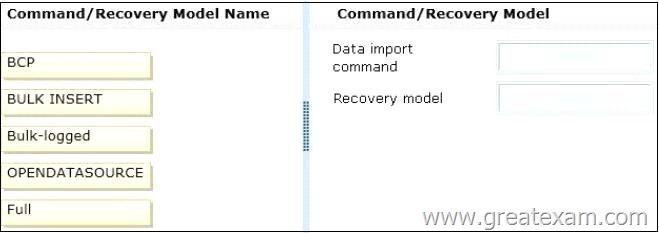
Answer: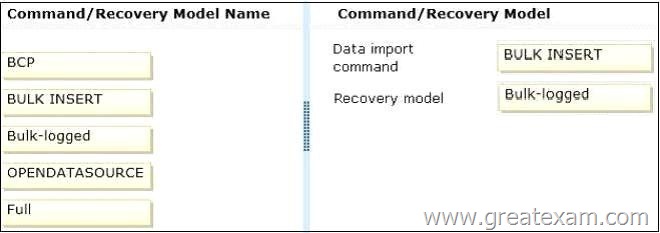
Explanation:
http://msdn.microsoft.com/en-us/library/ms162802.aspx
http://msdn.microsoft.com/en-us/library/ms188365.aspx
http://msdn.microsoft.com/en-us/library/ms175937.aspx
http://msdn.microsoft.com/en-us/library/aa337544.aspx
QUESTION 66
You administer a Microsoft SQL Server 2012 server that has SQL Server Integration Services (SSIS) installed.
You plan to deploy new SSIS packages to the server.
The SSIS packages use the Project Deployment Model together with parameters and Integration Services environment variables.
You need to configure the SQL Server environment to support these packages.
What should you do?
A. Create SSIS configuration files for the packages.
B. Create an Integration Services catalog.
C. Install Data Quality Services.
D. Install Master Data services.
Answer: B
Explanation:
http://msdn.microsoft.com/en-us/library/hh479588.aspx
http://msdn.microsoft.com/en-us/library/hh213290.aspx
http://msdn.microsoft.com/en-us/library/hh213373.aspx
QUESTION 67
You administer a Microsoft SQL Server database named Sales.
The database is 3 terabytes in size.
The Sales database is configured as shown in the following table.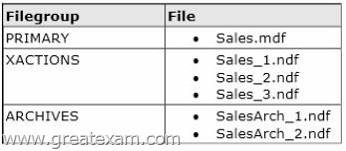
You discover that all files except Sales_2.ndf are corrupt.
You need to recover the corrupted data in the minimum amount of time.
What should you do?
A. Perform a restore from a full backup.
B. Perform a transaction log restore.
C. Perform a file restore.
D. Perform a filegroup restore.
Answer: A
Explanation:
http://technet.microsoft.com/en-us/library/ms187048.aspx
QUESTION 68
You administer a Microsoft SQL Server 2012 server that hosts a transactional database and a reporting database.
The transactional database is updated through a web application and is operational throughout the day. The reporting database is only updated from the transactional database.
The recovery model and backup schedule are configured as shown in the following table: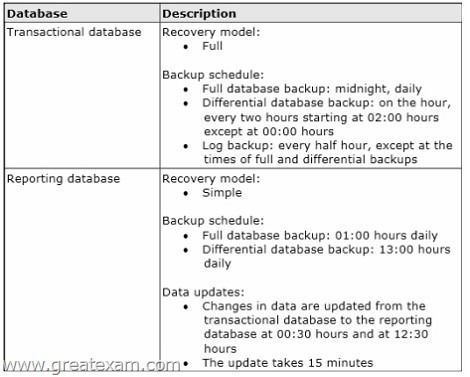
A. Restore the latest full backup, and restore the latest differential backup.
Then, restore the latest log backup.
B. Perform a point-in-time restore.
C. Restore the latest full backup.
D. Restore the latest full backup, and restore the latest differential backup.
Then, restore each log backup taken before the time of failure from the most recent differential backup.
E. Restore the latest full backup.
Then, restore the latest differential backup.
F. Restore the latest full backup.
Then, restore each differential backup taken before the time of failure from the most recent full backup.
G. Perform a page restore.
H. Perform a partial restore.
Answer: C
Explanation:
http://msdn.microsoft.com/en-us/library/ms187048.aspx
http://msdn.microsoft.com/en-us/library/ms186289.aspx
http://msdn.microsoft.com/en-us/library/ms175477.aspx
http://msdn.microsoft.com/en-us/library/ms189860.aspx
http://msdn.microsoft.com/en-us/library/ms179314.aspx
http://msdn.microsoft.com/en-us/library/ms175526.aspx
http://msdn.microsoft.com/en-us/library/ms191539.aspx
http://msdn.microsoft.com/en-us/library/ms191429.aspx
http://msdn.microsoft.com/en-us/library/ms191253.aspx
QUESTION 69
You administer a Microsoft SQL Server 2012 server that hosts a transactional database and a reporting database.
The transactional database is updated through a web application and is operational throughout the day. The reporting database is only updated from the transactional database.
The recovery model and backup schedule are configured as shown in the following table:
One of the hard disk drives that stores the reporting database fails at 16:40 hours.
You need to ensure that the reporting database is restored.
You also need to ensure that data loss is minimal.
What should you do?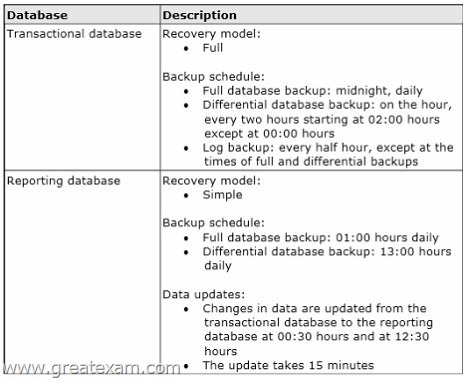
A. Restore the latest full backup. Then, restore each differential backup taken before the time of failure from the most recent full backup.
B. Perform a partial restore.
C. Restore the latest full backup, and restore the latest differential backup.
Then, restore the latest log backup.
D. Restore the latest full backup.
E. Perform a page restore.
F. Restore the latest full backup, and restore the latest differential backup.
Then, restore each log backup taken before the time of failure from the most recent differential backup.
G. Restore the latest full backup. Then, restore the latest differential backup.
H. Perform a point-in-time restore.
Answer: G
Explanation:
http://msdn.microsoft.com/en-us/library/ms187048.aspx
http://msdn.microsoft.com/en-us/library/ms186289.aspx
http://msdn.microsoft.com/en-us/library/ms175477.aspx
http://msdn.microsoft.com/en-us/library/ms189860.aspx
http://msdn.microsoft.com/en-us/library/ms179314.aspx
http://msdn.microsoft.com/en-us/library/ms175526.aspx
http://msdn.microsoft.com/en-us/library/ms191539.aspx
http://msdn.microsoft.com/en-us/library/ms191429.aspx
http://msdn.microsoft.com/en-us/library/ms191253.aspx
QUESTION 70
You administer a Microsoft SQL Server 2012 server that hosts a transactional database and a reporting database.
The transactional database is updated through a web application and is operational throughout the day. The reporting database is only updated from the transactional database.
The recovery model and backup schedule are configured as shown in the following table:
At 16:20 hours, you discover that pages 17, 137, and 205 on one of the database files are corrupted on the transactional database.
You need to ensure that the transactional database is restored.
You also need to ensure that data loss is minimal.
What should you do?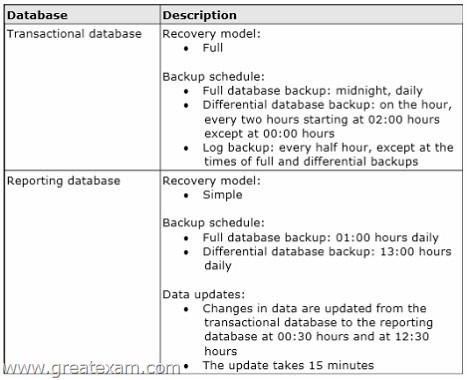
A. Perform a partial restore.
B. Restore the latest full backup, and restore the latest differential backup.
Then, restore each log backup taken before the time of failure from the most recent differential backup.
C. Perform a point-in-time restore.
D. Restore the latest full backup.
E. Restore the latest full backup, and restore the latest differential backup.
Then, restore the latest log backup.
F. Perform a page restore.
G. Restore the latest full backup.
Then, restore each differential backup taken before the time of failure from the most recent full backup.
H. Restore the latest full backup. Then, restore the latest differential backup.
Answer: F
Explanation:
http://msdn.microsoft.com/en-us/library/ms187048.aspx
http://msdn.microsoft.com/en-us/library/ms186289.aspx
http://msdn.microsoft.com/en-us/library/ms175477.aspx
http://msdn.microsoft.com/en-us/library/ms189860.aspx
http://msdn.microsoft.com/en-us/library/ms179314.aspx
http://msdn.microsoft.com/en-us/library/ms175526.aspx
http://msdn.microsoft.com/en-us/library/ms191539.aspx
http://msdn.microsoft.com/en-us/library/ms191429.aspx
http://msdn.microsoft.com/en-us/library/ms191253.aspx
QUESTION 71
You administer a Microsoft SQL Server 2012 instance.
The instance contains a database that supports a retail sales application.
The application generates hundreds of transactions per second and is online 24 hours per day and 7 days per week.
You plan to define a backup strategy for the database.
You need to ensure that the following requirements are met:
– No more than 5 minutes worth of transactions are lost.
– Data can be recovered by using the minimum amount of administrative effort.
What should you do? Choose all that apply.
A. Configure the database to use the SIMPLE recovery model.
B. Create a DIFFERENTIAL database backup every 4 hours.
C. Create a LOG backup every 5 minutes.
D. Configure the database to use the FULL recovery model.
E. Create a FULL database backup every 24 hours.
F. Create a DIFFERENTIAL database backup every 24 hours.
Answer: BCDE
Explanation:
http://msdn.microsoft.com/en-us/library/ms187048.aspx
http://msdn.microsoft.com/en-us/library/ms186289.aspx
http://msdn.microsoft.com/en-us/library/ms175477.aspx
http://msdn.microsoft.com/en-us/library/ms189860.aspx
http://msdn.microsoft.com/en-us/library/ms179314.aspx
http://msdn.microsoft.com/en-us/library/ms175526.aspx
http://msdn.microsoft.com/en-us/library/ms191539.aspx
http://msdn.microsoft.com/en-us/library/ms191429.aspx
http://msdn.microsoft.com/en-us/library/ms191253.aspx
QUESTION 72
You administer a Microsoft SQL Server 2012 server that hosts a transactional database and a reporting database.
The transactional database is updated through a web application and is operational throughout the day. The reporting database is only updated from the transactional database.
The recovery model and backup schedule are configured as shown in the following table:
At 14:00 hours, you discover that pages 71, 520, and 713 on one of the database files are corrupted on the reporting database.
You need to ensure that the databases are restored.
You also need to ensure that data loss is minimal.
What should you do?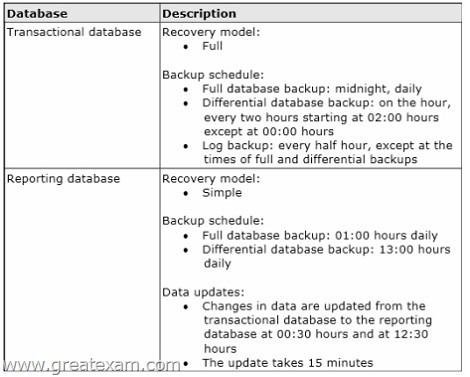
A. Perform a partial restore.
B. Restore the latest full backup, and restore the latest differential backup.
Then, restore each log backup taken before the time of failure from the most recent differential backup.
C. Restore the latest full backup.
D. Restore the latest full backup, and restore the latest differential backup.
Then, restore the latest log backup.
E. Perform a page restore.
F. Restore the latest full backup. Then, restore each differential backup taken before the time of failure from the most recent full backup.
G. Perform a point-in-time restore.
H. Restore the latest full backup. Then, restore the latest differential backup.
Answer: H
Explanation:
http://msdn.microsoft.com/en-us/library/ms187048.aspx
http://msdn.microsoft.com/en-us/library/ms186289.aspx
http://msdn.microsoft.com/en-us/library/ms175477.aspx
http://msdn.microsoft.com/en-us/library/ms189860.aspx
http://msdn.microsoft.com/en-us/library/ms179314.aspx
http://msdn.microsoft.com/en-us/library/ms175526.aspx
http://msdn.microsoft.com/en-us/library/ms191539.aspx
http://msdn.microsoft.com/en-us/library/ms191429.aspx
http://msdn.microsoft.com/en-us/library/ms191253.aspx
QUESTION 73
Drag and Drop Question
You administer a Microsoft SQL Server 2012 environment that contains a production SQL Server 2005 instance named SQL2005 and a development SQL Server 2012 instance named SQL2012. The development team develops a new application that uses the SQL Server 2012 functionality. You are planning to migrate a database from SQL2005 to SQL2012 so that the development team can test their new application.
You need to migrate the database without affecting the production environment.
Which three actions should you perform in sequence? (To answer, move the appropriate actions from the list of actions to the answer area and arrange them in the correct order.)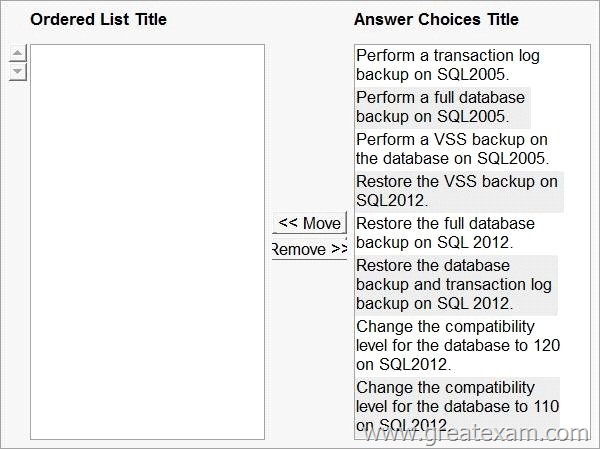
Answer: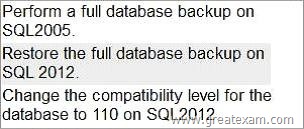
Explanation:
http://msdn.microsoft.com/en-us/library/ms187048.aspx
http://msdn.microsoft.com/en-us/library/ms186289.aspx
http://msdn.microsoft.com/en-us/library/ms175477.aspx
http://msdn.microsoft.com/en-us/library/ms189860.aspx
http://msdn.microsoft.com/en-us/library/ms179314.aspx
http://msdn.microsoft.com/en-us/library/ms175526.aspx
http://msdn.microsoft.com/en-us/library/ms191539.aspx
http://msdn.microsoft.com/en-us/library/ms191429.aspx
http://msdn.microsoft.com/en-us/library/ms191253.aspx
QUESTION 74
You use a contained database named ContosoDb within a domain.
You need to create a user who can log on to the ContosoDb database.
You also need to ensure that you can port the database to different database servers within the domain without additional user account configurations.
Which type of user should you create?
A. User mapped to a certificate
B. SQL user without login
C. SQL user with login
D. SQL user without login
E. User mapped to an asymmetric key
F. Login mapped to a virtual account
Answer: B
Explanation:
http://msdn.microsoft.com/en-us/library/ff929071.aspx
QUESTION 75
Drag and Drop Question
You administer a Microsoft SQL Server 2012 database.
The database is backed up according to the following schedule:
– Daily full backup at 23:00 hours.
– Differential backups on the hour, except at 23:00 hours.
– Log backups every 10 minutes from the hour, except on the hour.
The database uses the Full recovery model. A developer accidentally drops a number of tables and stored procedures from the database between 22:40 hours and 23:10 hours.
You perform a database restore at 23:30 hours to recover the dropped table.
You need to restore the database by using the minimum amount of administrative effort.
You also need to ensure minimal data loss.
Which three actions should you perform in sequence? (To answer, move the appropriate actions from the list of actions to the answer area and arrange them in the correct order.)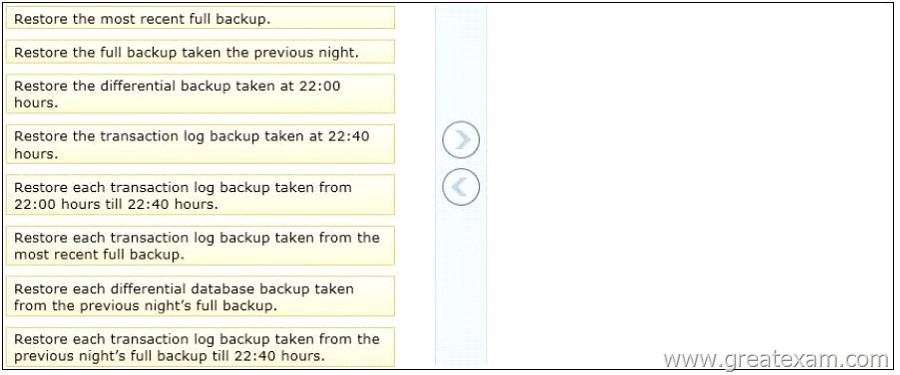
Answer: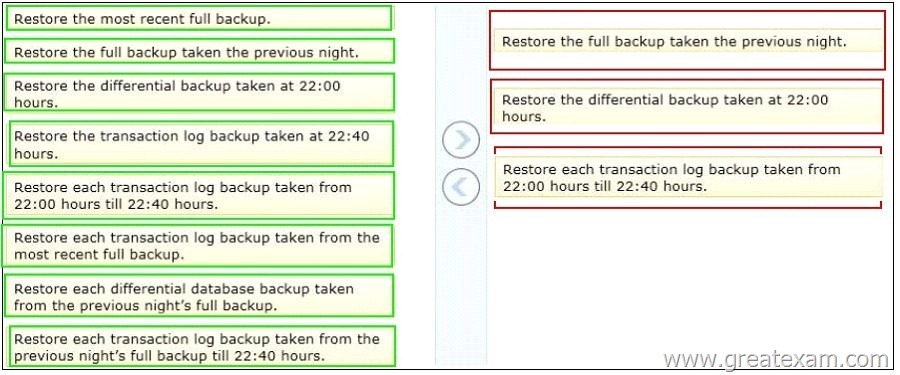
Explanation:
http://msdn.microsoft.com/en-us/library/ms187048.aspx
http://msdn.microsoft.com/en-us/library/ms186289.aspx
http://msdn.microsoft.com/en-us/library/ms175477.aspx
http://msdn.microsoft.com/en-us/library/ms189860.aspx
http://msdn.microsoft.com/en-us/library/ms179314.aspx
http://msdn.microsoft.com/en-us/library/ms175526.aspx
http://msdn.microsoft.com/en-us/library/ms191539.aspx
http://msdn.microsoft.com/en-us/library/ms191429.aspx
http://msdn.microsoft.com/en-us/library/ms191253.aspx
QUESTION 76
Drag and Drop Question
You administer a Microsoft SQL Server 2012 clustered instance that has two nodes named Node 1 and Node2.
Node 1 fails and the cluster fails over to Node 2.
You need to replace Node 1 and add it to the cluster.
Which four actions should you perform in sequence? (To answer, move the appropriate actions from the list of actions to the answer area and arrange them in the correct order.)
Answer: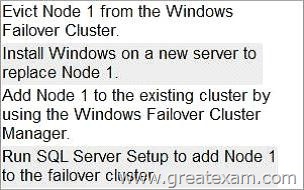
Explanation:
http://technet.microsoft.com/en-us/library/ms181075.aspx
QUESTION 77
Drag and Drop Question
You administer a Microsoft SQL Server instance.
You use a two-node SQL Server failover cluster.
Node B is primary, and Node A is secondary.
You need to install a security patch on both nodes.
You need to ensure that the following requirements are met:
– Both nodes receive the update.
– Downtime is minimized.
– No data is lost.
Which three actions should you perform in sequence? (To answer, move the appropriate actions from the list of actions to the answer area and arrange them in the correct order.)
Answer:
Explanation:
http://technet.microsoft.com/en-us/library/ms191295.aspx
http://msdn.microsoft.com/en-us/library/ms191009.aspx
QUESTION 78
Drag and Drop Question
You administer a Microsoft SQL Server database.
Service accounts for SQL Agent are configured to use a local user.
A Microsoft SQL Server Integration Services (SSIS) job step has been created within a SQL Server Agent job.
The SSIS package accesses a network share when exporting data from a SQL Server database. When you execute the SQL Server Agent job, it fails due to a permissions failure on a share on a remote server.
You need to ensure that the SQL Server Agent job can execute the SSIS package.
Which four actions should you perform in sequence? (To answer, move the appropriate actions from the list of actions to the answer area and arrange them in the correct order.)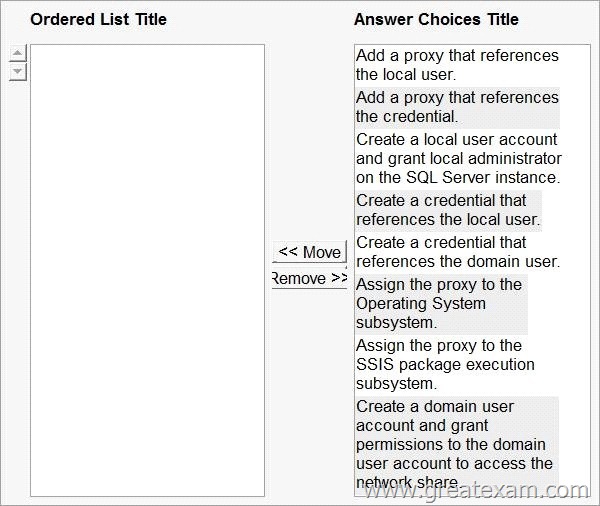
Answer:
Explanation:
http://msdn.microsoft.com/en-us/library/ms175834.aspx
http://msdn.microsoft.com/en-us/library/ms189522.aspx
http://msdn.microsoft.com/en-us/library/ms190703.aspx
http://msdn.microsoft.com/en-us/library/ms161950.aspx
QUESTION 79
You administer a Microsoft SQL Server 2012 instance named SQL2012 that hosts an OLTP database of 1 terabyte in size.
The database is modified by users only from Monday through Friday from 09:00 hours to 17:00 hours.
Users modify more than 30 percent of the data in the database during the week.
Backups are performed as shown in the following schedule:
The Finance department plans to execute a batch process every Saturday at 09:00 hours.
This batch process will take a maximum of 8 hours to complete.
The batch process will update three tables that are 10 GB in size.
The batch process will update these tables multiple times.
When the batch process completes, the Finance department runs a report to find out whether the batch process has completed correctly.
You need to ensure that if the Finance department disapproves the batch process, the batch operation can be rolled back in the minimum amount of time.
What should you do on Saturday?
A. Perform a differential backup at 08:59 hours.
B. Record the LSN of the transaction log at 08:59 hours.
Perform a transaction log backup at 17:01 hours.
C. Create a database snapshot at 08:59 hours.
D. Record the LSN of the transaction log at 08:59 hours.
Perform a transaction log backup at 08:59 hours.
E. Create a marked transaction in the transaction log at 08:59 hours.
Perform a transaction log backup at 17:01 hours.
F. Create a marked transaction in the transaction log at 08:59 hours.
Perform a transaction log backup at 08:59 hours.
Answer: C
QUESTION 80
Drag and Drop Question
You administer a Microsoft SQL Server 2012 database.
All database traffic to the SQL Server must be encrypted by using secure socket layer (SSL) certificates or the connection must be refused.
Network administrators have deployed server certificates to the Windows store of all Windows servers ortn the network from a trusted Ceificate Authority.
This is the only Certificate Authority allowed to distribute certificates on the network.
You enable the Force Encryption flag for the MSSQLServer protocols, but client computers are unable to connect.
They receive the following error message:
“A connection was successfully established with the server, but then an error occurred during the pre-login handshake, (provider: SSL Provider, error: 0 – The certificate chain was issued by an authority that is not trusted.) (Microsoft SQL Server)”
You notice the following entry in the SQL Server log:
“A self-generated certificate was successfully loaded for encryption.”
You need to configure SQL Server to encrypt all client traffic across the network.
You also need to ensure that client computers are able to connect to the server by using a trusted certificate.
Which three actions should you perform in sequence? (To answer, move the appropriate actions from the list of actions to the answer area and arrange them in the correct order.)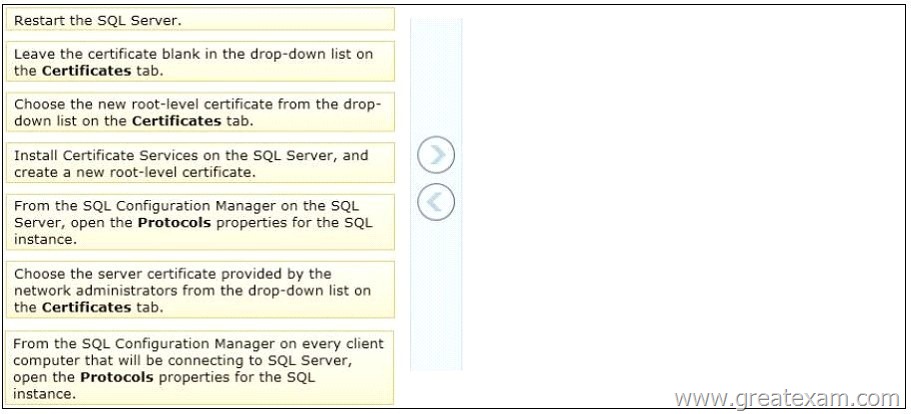
Answer: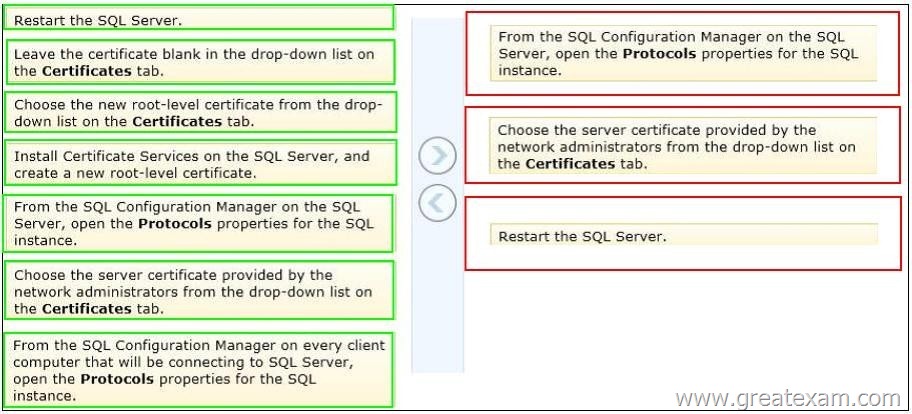
Explanation:
http://thesqldude.com/2012/04/21/setting-up-ssl-encryption-for-sql-server-using-certificates-issues-tips-tricks/
GreatExam offers you all the 70-458 exam questions which are the same as your real test with 100% correct and coverage rate. We provide the latest full version of 70-458 PDF and VCE dumps to ensure your 70-458 exam 100% pass.